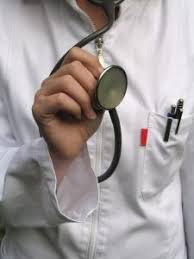April 30th, 2011 by admin in Health Tips
No Comments »


Extra fat that accumulates around the abdomen goes by many names: beer belly, spare tire, love handles, apple shape, middle-age spread, and the more technical “abdominal obesity.” No matter what the name, it is the shape of risk.
Abdominal obesity increases the risk of heart attack, stroke, diabetes, erectile dysfunction, and other woes. The danger zone is a waist size above 40 inches for men and 35 inches for women.
As I describe in the April 2011 issue of the Harvard Men’s Health Watch, beer is not specifically responsible for a beer belly. What, then, is to blame? Calories. Take in more calories with food and drink than you burn up with exercise, and you’ll store the excess energy in fat cells.
Many studies indicate that people who store their extra fat around the midsection (apple shape) are at greater risk for heart and other problems than people who carry it around their thighs (pear shape). An analysis of 58 earlier studies covering over 220,000 men and women suggests that excess fat is harmful no matter where it ends up. This work was published in The Lancet. Read more »
*This blog post was originally published at Harvard Health Blog*
February 23rd, 2011 by RyanDuBosar in Better Health Network, Research
No Comments »

 Add coronary stent thrombosis to the list of cardiac events influenced by circadian rhythms, with more events occurring during the early morning hours and in a summertime window of late July and early August.
Add coronary stent thrombosis to the list of cardiac events influenced by circadian rhythms, with more events occurring during the early morning hours and in a summertime window of late July and early August.
Coronary stent thrombosis joins several other adverse cardiac events that also follow a circadian pattern, such as stroke, unstable angina pectoris, acute myocardial infarction and sudden cardiac death, according to researcher published in JACC: Cardiovascular Interventions.
Most studies that addressed circadian variations in cardiovascular disease were done before the advent of stents, so, researcher from Mayo Clinic-Rochester conducted a retrospective analysis of medical records and the clinic’s registry, finding 124 patients who presented with coronary stent thrombosis between February 1995 and August 2009.
Researchers determined the time of day, day of week, and season of year that the stent thrombosis occurred and recorded when potential triggers were present. In addition, the team categorized each stent thrombosis based on the number of days since the initial stenting procedure: early=0 to 30, late=31 to 360 days, very late=more than 360 days.
The association between the onset of stent thrombosis was lowest at 8 p.m. and highest at 7 a.m. (P=0.006). However, when the team divided the analysis into early, late, and very late stent thrombosis, only the association between early stent thrombosis and time of day remained significant (P=0.030, P=0.537, P=0.096, respectively). Day of week wasn’t associated, but stent thrombosis rates peaked between the end of July and the beginning of August (P=0.036). Read more »
*This blog post was originally published at ACP Internist*
February 21st, 2011 by Toni Brayer, M.D. in Health Tips, Opinion
No Comments »

 “But doc, my blood pressure is always normal at home.” I wish I had a dollar for every time I have heard that line and I know it is true. When some patients come to see me, their blood pressure is abnormally high (above 130/90). This is known as “white-coat hypertension.” Although it has been thought to be from anxiety about seeing the doctor, even long-established patients who have no conscious anxiety can exhibit elevated blood pressure in the office.
“But doc, my blood pressure is always normal at home.” I wish I had a dollar for every time I have heard that line and I know it is true. When some patients come to see me, their blood pressure is abnormally high (above 130/90). This is known as “white-coat hypertension.” Although it has been thought to be from anxiety about seeing the doctor, even long-established patients who have no conscious anxiety can exhibit elevated blood pressure in the office.
Because blood pressure naturally fluctuates and the office visit is not a “normal” setting, it is important for patients who have high blood pressure (hypertension) to have their own blood pressure cuff at home. Now that devices are automated and easy to use, everyone with hypertension should be monitoring their blood pressure in the comfort of their own home. I advise multiple readings over a week at different times of day. Get a reading when resting and when rushing around. Take your blood pressure after you exercise and after a meal. It is important to keep a log and write it down. Only then can we see patterns and know if the blood pressure is controlled or not.
Blood pressure readings in the doctors office are not necessarily the most accurate. Patients are often rushed trying to get parked and in on time. Medical assistants can use the wrong size cuff or not position the arm correctly. Listening (auscultation) is not very accurate due to human error. It is the multiple readings over time that give a more accurate picture of blood pressure control.
High blood pressure in the office can be true hypertension or it can be white-coat hypertension that is usually controlled at home. If a patient is on blood pressure medication and has controlled blood pressure at home, I will not add more medication just because they are elevated in the office. If a patient has not been diagnosed with hypertension and his or her blood pressure is elevated in the office, he or she is advised to get their own blood pressure cuff for at home and return with readings for us to review. This way we can minimize unnecessary and expensive medication and make sure we are protecting the patient as well.
*This blog post was originally published at EverythingHealth*
February 12th, 2011 by RyanDuBosar in News, Research
No Comments »

 Enriched chicken feed may have resulted in eggs having less cholesterol and more Vitamin D than previously measured, reports the U.S. Department of Agriculture (USDA).
Enriched chicken feed may have resulted in eggs having less cholesterol and more Vitamin D than previously measured, reports the U.S. Department of Agriculture (USDA).
A large egg today has about 185 milligrams of cholesterol, down 14 percent from 215 milligrams in 2002, according to new research from the USDA’s Agricultural Research Service, reports USA Today. Also, an egg today has 41 international units (IUs) of Vitamin D, up 64 percent from 25 IUs measured in 2002. (That’s still only about 7 percent of the 600 IUs recommended per day.)
The agency regularly does nutrient checks on popular foods, this time analyzing eggs taken from store shelves in 12 locations around the country. The American Egg Board said in a press release that hen feed is made up mostly of corn, soybean meal, vitamins and minerals. Nutrition researchers at Iowa State University are also looking into reasons why cholesterol in eggs is decreasing.
The government’s “Dietary Guidelines for Americans” recommend that most people eat less than 300 milligrams of total dietary cholesterol a day, and people at a high risk of cardiovascular disease should eat less than 200 milligrams a day. The average American man consumes about 337 milligrams of cholesterol a day and the average woman consumes 217 milligrams, reports the Los Angeles Times.
One egg a day fits within the average, healthy American’s diet, reports WebMD, citing research funded by the Centers for Disease Control and Prevention and by the American Egg Board — owners of the slogan “the incredible, edible egg.”
*This blog post was originally published at ACP Internist*
February 10th, 2011 by PJSkerrett in Health Tips, Research
No Comments »

 As a youngster, I loved being part of the baby boom — it meant there were dozens of kids on my block who were ready to play hide-and-seek or join mysterious clubs. Now that I’m of an AARP age, there’s one club I don’t want to join: The one whose members have bypass scars, pacemakers, or other trappings of cardiovascular disease. The American Heart Association’s (AHA) gloomy new forecast on cardiovascular disease tells me it won’t be easy to avoid.
As a youngster, I loved being part of the baby boom — it meant there were dozens of kids on my block who were ready to play hide-and-seek or join mysterious clubs. Now that I’m of an AARP age, there’s one club I don’t want to join: The one whose members have bypass scars, pacemakers, or other trappings of cardiovascular disease. The American Heart Association’s (AHA) gloomy new forecast on cardiovascular disease tells me it won’t be easy to avoid.
The AHA foresees sizeable increases in all forms of cardiovascular disease (see table) between now and 2030, the year all of the boomers are age 65 and older. Those increases will translate into an additional 27 million people with high blood pressure, eight million with coronary heart disease, four million with stroke, and three million with heart failure. That will push the number of adult Americans with some form of heart disease to 110 million.

(Percentages refer to the percentage of Americans aged 18 years and older.)
If the AHA’s projections are accurate, the cost of treating cardiovascular disease would balloon from $272 billion today to $818 billion in 2030. Add in the cost of lost productivity, and it jumps to more than $1 trillion. Yikes!
Although obesity and inactivity are part of the problem, much of the increase comes from the graying of the baby boom. We can’t stop boomers from aging, but we can fight cardiovascular disease, a condition the AHA calls “largely preventable.” Read more »
*This blog post was originally published at Harvard Health Blog*





 Add coronary stent thrombosis to the list of cardiac events influenced by circadian rhythms, with more events occurring during the early morning hours and in a summertime window of late July and early August.
Add coronary stent thrombosis to the list of cardiac events influenced by circadian rhythms, with more events occurring during the early morning hours and in a summertime window of late July and early August.










